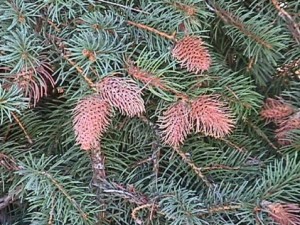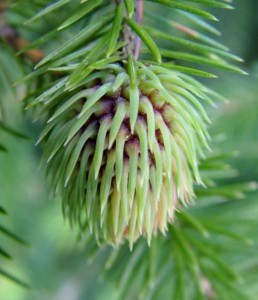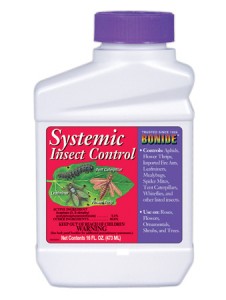Brown Tips on Spruce Trees?
Brown Tips on Spruce Trees?
I notice the new growth on spruce trees in Idaho Falls is just starting to emerge from the brown caps at the tips of the branches. That reminds me that now is the best time to spray to prevent damage from the Spruce Gall Adelgid (Aphid). So I thought I would share this Q & A with you from the Forum page of Idaho Community Forestry Partners.
 Q. The branches of my spruce tree are tipped with brown prickly things that look like pinecones. But the cones higher up in the tree don’t look like these. What are they and will they damage our tree? ~Sarah H., Pocatello
Q. The branches of my spruce tree are tipped with brown prickly things that look like pinecones. But the cones higher up in the tree don’t look like these. What are they and will they damage our tree? ~Sarah H., Pocatello
A. The growths on the tips of your spruce are galls, sometimes referred to as spruce pineapple galls because they resemble pineapples. Although they are odd looking, they rarely cause serious damage to the tree. The Cooley spruce gall aphid is responsible for these galls. This insect has multiple forms. Its life cycle requires two hosts over two years: one year on spruce and one year on Douglas-fir or another spruce. And it is misnamed – although it is closely related to aphids, it is not an aphid.

Copyright © 2007 Cheryl Moorehead
On spruce, winged adults lay large masses of eggs on the underside of branches in the spring. As the hatched nymphs feed, they induce the formation of greenish-purple cone-like galls that encase the feeding insects, providing protection and food. By late summer, winged adults emerge from cracks in the drying galls and migrate to Douglas-fir or another spruce. Winged adults overwinter on Douglas-fir needles and lay masses of eggs in spring. The eggs become woolly aphids that feed on the Douglas-fir needles, causing them to become yellow and twisted. Then the winged adults fly back to the spruce in late summer and the cycle begins again.
Although the galls are conspicuous, they are not a serious problem. They usually kill the terminal/end growth of the branch – a poor form of pruning, to be sure. Removing galls is not a helpful control because the insect has already migrated and will never use the browned gall again. Healthy trees seem to be more resistant to the aphid than stressed trees – yet another reason to deep water and mulch within the dripline. Some individual trees are fairly resistant, perhaps due to leaf waxiness.
 The best control is a late spring frost and strong winds; these destroy the overwintering Cooley spruce gall adelgids. But most of us don’t wish for late spring frosts or strong winds for obvious reasons. If you find the the galls make the tree too unattractive, you can spray right now, when the new needles are emerging, with an insecticide containing acephate. We like Bonide Systemic Insect Control.
The best control is a late spring frost and strong winds; these destroy the overwintering Cooley spruce gall adelgids. But most of us don’t wish for late spring frosts or strong winds for obvious reasons. If you find the the galls make the tree too unattractive, you can spray right now, when the new needles are emerging, with an insecticide containing acephate. We like Bonide Systemic Insect Control.


